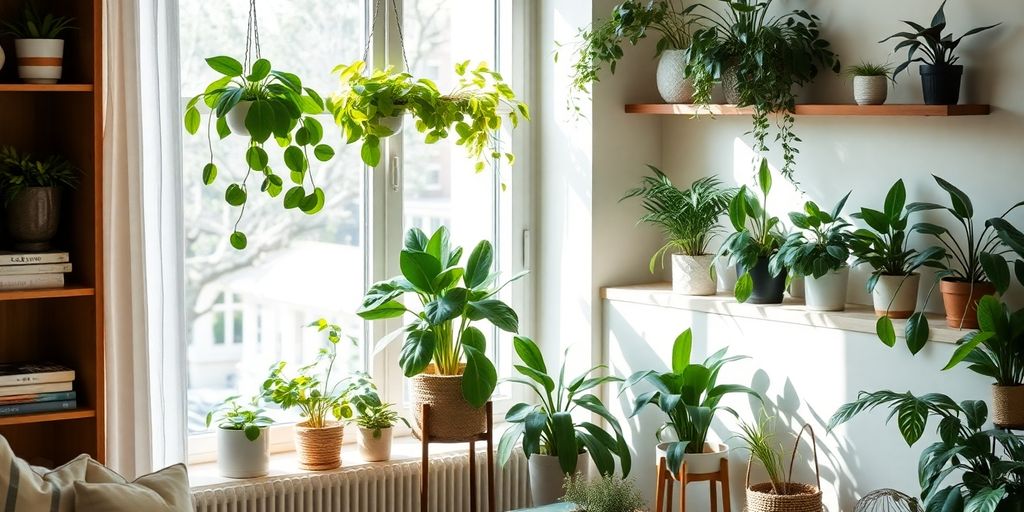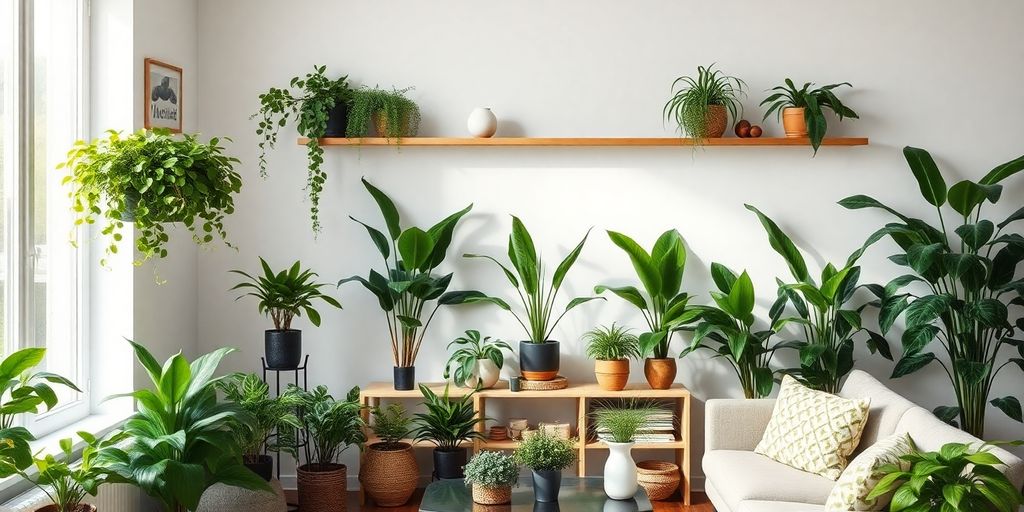How to decorate your home with plants without overdoing it is an art that blends nature and style with subtlety. Adding greenery can transform any space, but too much can overwhelm your decor. Finding the right balance is key to creating a welcoming and fresh atmosphere.
Plants bring life and color indoors, but choosing the right types and placements makes all the difference. Understanding how to use plants as accents rather than focal points helps maintain harmony in your home. With a thoughtful approach, you can enjoy the benefits of plants without cluttering your space.
In this article, we’ll explore simple yet effective tips to help you decorate with plants in a tasteful way. Whether you’re a plant lover or just starting out, these ideas will inspire you to create a stylish green environment. Keep reading to master the art of subtle plant decor.
Key takeaways
- Find the right spots for your plants to create a balanced look.
- Opt for low-maintenance plants if you’re busy, and mix in seasonal varieties for change.
- Choose stylish pots and stands to enhance your plants without taking over the room.
Creating balance with plant placement

Okay, so you’re ready to bring some green into your home, but you don’t want it to look like a jungle, right? I get it. It’s all about finding that sweet spot where the plants complement your space without overwhelming it. I’ve definitely been there, done that – accidentally turned my living room into a greenhouse once. Not my finest moment, haha. Let’s talk about how to avoid that.
Choosing the right spots for plants
First things first: consider the light. I mean, it sounds obvious, but it’s easy to get caught up in how a plant looks in a certain spot and forget that it needs actual sunlight to, you know, live. I usually check which direction my windows face and then match the plant to the light level. For example:
- South-facing windows: These get the most light, so they’re perfect for sun-loving plants like succulents or cacti.
- North-facing windows: These get very little direct light, so they’re better for low-light plants like snake plants or ZZ plants.
- East- or west-facing windows: These get moderate light, so they’re good for a variety of plants.
Also, think about foot traffic. You don’t want to put a delicate fern in a spot where it’s going to get bumped into every five minutes. Trust me, I’ve learned this the hard way. And don’t forget about humidity! Bathrooms can be great for plants that love moisture, like ferns or orchids.
Layering heights for visual interest
Okay, this is where things get fun. Instead of just lining up all your plants on a windowsill, try creating some visual interest by varying the heights. I like to use a combination of:
- Tall plants: These can go on the floor in a nice pot or on a plant stand.
- Medium plants: These can go on shelves or tables.
- Small plants: These can go on windowsills or desks.
This creates a more dynamic and interesting display. You can also use hanging plants to add some vertical interest. Just make sure they’re not too high up, or you’ll have a hard time watering them. I also like to group plants with similar textures and colors together to create a cohesive look.
For example, a group of succulents with different shapes and sizes can look really cool. Or a collection of ferns with different shades of green can add a touch of elegance to a room.
Selecting the right plants for your space
Okay, so you’re ready to bring some green into your home, but where do you even start? It’s not just about grabbing the first pretty plant you see at the store. Trust me, I’ve been there, done that, and ended up with a crispy fern graveyard. Choosing the right plants is about matching them to your lifestyle and your home’s environment. Let’s break it down.
Low-maintenance options for busy lifestyles
Let’s be real, not all of us have the time to be plant whisperers. If you’re constantly on the go, opting for low-maintenance plants is the way to go. These guys are pretty forgiving and won’t throw a fit if you forget to water them for a week (or two… no judgment). Here are a few of my favorites:
- Snake Plant (Sansevieria): Seriously, these things are practically indestructible. They can handle low light and infrequent watering.
- ZZ Plant (Zamioculcas zamiifolia): Another super easy one. They thrive on neglect, which is perfect for busy folks.
- Pothos: These trailing plants are not only low-maintenance but also super easy to propagate. Just snip a piece and stick it in water, and you’ll have a whole new plant in no time.
Incorporating seasonal plants for variety
One way to keep things interesting is to switch out your plants with the seasons. It adds a little bit of freshness and keeps your decor from getting stale. Plus, it’s a great way to celebrate the changing times of the year. Here’s how I usually roll:
- Spring: Think bright and cheerful. Tulips or daffodils in pots can bring a pop of color indoors.
- Summer: Herbs like basil, mint, and rosemary do great indoors during the summer months. Plus, you can actually use them in your cooking!
- Fall: Mums are a classic fall choice. They come in all sorts of colors and are relatively easy to care for.
- Winter: Amaryllis bulbs are perfect for winter. You can watch them grow and bloom indoors, bringing a little bit of life to those cold, dark days.
Enhancing your decor with plant accessories

Okay, so you’ve got your plants picked out and you’re ready to go. But hold on a sec, because the right accessories can really take things to the next level. I’ve seen some folks just plop a plant in a basic plastic pot and call it a day, but trust me, a little extra thought here makes a big difference. It’s like putting the right frame on a painting, ya know?
Choosing stylish pots and planters
The pot is just as important as the plant itself. Seriously! Think about the overall vibe you’re going for. A sleek, modern ceramic pot can look amazing with a snake plant, while a rustic terracotta pot might be perfect for a trailing ivy.
Don’t be afraid to mix and match, but try to keep a consistent color palette or style to avoid things looking too chaotic. I personally love hitting up flea markets for unique vintage planters – you can find some real gems if you’re willing to dig around a bit. Just make sure whatever you choose has proper drainage, or your plant won’t be long for this world.
Using plant stands to elevate your greenery
Plant stands are a game-changer, y’all. They not only add visual interest by varying the heights of your plants, but they also help protect your floors from water damage. Plus, they can turn a simple potted plant into a real statement piece.
I’ve got a few different styles scattered around my place – a mid-century modern stand for my fiddle-leaf fig, a wrought-iron one for my fern, and even a simple wooden stool for a small succulent. It’s all about finding what works with your space and your plants. Here are some things to consider when choosing a plant stand:
- Height: Consider the height of your plant and the overall look you’re trying to achieve. Taller stands can create a more dramatic effect, while shorter stands are great for smaller plants or adding subtle height variations.
- Material: Choose a material that complements your decor and is durable enough to support the weight of your plant. Wood, metal, and ceramic are all popular options.
- Style: Look for a stand that matches your personal style and the overall aesthetic of your home. There are tons of different styles out there, from minimalist to bohemian to industrial, so take your time and find something you love.
Final thoughts on plant cecor
So, there you have it! Decorating your home with plants doesn’t have to be overwhelming. Just remember to keep it simple and choose plants that fit your space and lifestyle. A few well-placed greenery can really make a difference without cluttering your home.
Think about the vibe you want to create and pick plants that match that. And hey, don’t forget to have fun with it! Experiment a little, and see what works best for you. Happy decorating!
Frequently asked questions
How do I choose the best spots for my plants?
Look for areas with good light but not too much direct sun. Places like windowsills or corners can work well. Think about where you spend the most time and put plants there to enjoy their beauty.
What are some easy plants for beginners?
Some great low-maintenance plants include pothos, snake plants, and peace lilies. They don’t need much care and can survive in different light conditions.
How can I make my plant pots look stylish?
Choose pots that match your room’s colors or style. You can also use plant stands to lift your plants off the ground, making them more visible and adding a fun design element.
